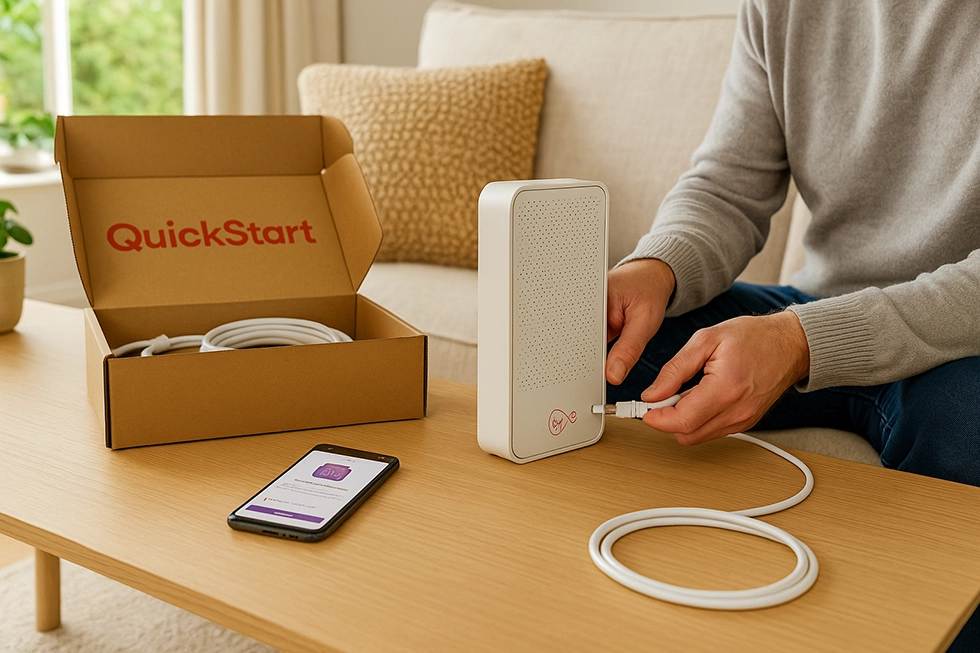Hyperoptic 1Gb Hyperfast Fibre Broadband

Why Choose Hyperoptic 1Gb?
Hyperoptic 1Gb Hyperfast fibre broadband is a gigabit package that delivers something most UK broadband providers can’t match: truly symmetrical speeds. While competitors often advertise fast downloads but limit uploads to a fraction of that speed, Hyperoptic’s full fibre network offers 900Mbps download and 900Mbps upload.
This makes a genuine difference if you regularly upload large files, host video calls, back up data to the cloud, or stream content to platforms like Twitch or YouTube. The connection uses fibre-to-the-premises (FTTP) technology all the way into your home, avoiding the copper cabling that slows down many traditional broadband services.
The company also offers contract flexibility with clear pricing for each option. You can choose between 12-month and 24-month terms, with transparent costs and scheduled increases shown before you commit.
Hyperoptic Broadband Deals in Your Area

1Gb Fibre
Broadband Only

1Gb Fibre
Broadband and Phone
What’s Included in Hyperoptic 1Gb Hyperfast
Hyperoptic’s 1Gb package comes with everything you need to get connected, though activation fees apply (commonly discounted in promotional offers).
The connection itself delivers 900Mbps symmetrical—the same speed for uploads and downloads. This is genuine full fibre, not part-fibre services that still use copper cabling for the final stretch.
Router included comes as part of the package. For gigabit connections, Hyperoptic supplies the Hyperhub (Zyxel EX3301), a Wi-Fi 6 router with dual-band support, four gigabit Ethernet ports, and 2×2 MIMO technology. This router is capable of actually delivering the speeds you’re paying for across your home, unlike some provider-supplied equipment that becomes the bottleneck.
Installation requires an engineer visit to complete setup, ensuring everything works properly before leaving. Standard activation fees apply, though promotions frequently discount these substantially—sometimes to as low as £19 on current offers.
Router delivery is free, with the equipment typically arriving before your activation date so everything’s ready when your connection goes live.
The package is broadband-only by default, but you can add home phone service with call plan packages starting from £3 monthly if needed.
Cost
24-month contract: Offers the lowest starting monthly rate but includes scheduled price increases at fixed intervals. For example, your bill might start at one amount, then rise by £3 in April 2026 and another £3 in April 2027. These increases are shown clearly when you sign up, letting you calculate your total two-year cost before committing.
12-month contract: Costs more monthly at the start but gives you flexibility if you’re uncertain about your long-term plans. You’ll still experience scheduled price increases that fall within your 12-month period, but only one annual rise rather than two.
Activation fees: Activation usually costs £19. however, our exclusive offer includes free activation.
Optional extra: Home phone service with call plan packages from £3 monthly.
What you need to know
Satisfaction period: Hyperoptic offers a 30-day satisfaction window from activation. However, cancellation within this period may incur charges to cover costs and services already used. You’ll need to give 30 days’ notice to cancel.
Early termination: Cancelling mid-contract triggers charges based on remaining months at your agreed rate. Even if you move to an address without Hyperoptic coverage during your minimum term, early termination fees may still apply. Check your contract terms and remaining period before cancelling.
Moving house: If your new property has Hyperoptic, you may be able to transfer service. If your new address isn’t covered and you’re still within your minimum term, early termination fees typically apply—contact customer service to discuss your specific situation.
Price increases: Any mid-contract rises are fixed amounts shown at sign-up, following Ofcom’s 2025 requirements. You’ll know exactly when increases happen and by how much before signing up.
Payment: Monthly by Direct Debit. There are no quarterly or annual payment options.
Want more detail about Hyperoptic? Read our complete Hyperoptic broadband review covering service quality, reliability, and detailed comparisons with other providers.
Equipment and Router
The Hyperhub (Zyxel EX3301) router supplied with gigabit packages is genuinely capable of delivering the speeds you’re paying for, which isn’t always true of provider-supplied equipment.
This Wi-Fi 6 router offers dual-band connectivity across 2.4GHz and 5GHz frequencies, with 2×2 MIMO technology that improves coverage and handles multiple devices efficiently. The four gigabit Ethernet ports let you connect wired devices at full speed—essential for getting the maximum performance from a gigabit connection. There’s also one WAN port for the incoming fibre connection.
Coverage reaches typical 3-4 bedroom homes without dead spots, though larger properties or homes with thick walls might benefit from a mesh system or additional access points. The Wi-Fi 6 standard is future-proofed for newer devices and offers better performance in crowded environments with many connected gadgets.
Using your own router is possible if you prefer. Hyperoptic provides the login credentials needed to configure third-party routers, and many customers successfully use equipment from manufacturers like Asus, UniFi, or TP-Link. This gives you more control over advanced features, parental controls, or mesh networking if the supplied router doesn’t meet your specific needs.
Installation
Getting connected depends on whether your building already has Hyperoptic infrastructure installed.
Existing infrastructure: If your apartment block or development already has Hyperoptic wiring in place, installation is relatively straightforward. An engineer visit is required—Hyperoptic doesn’t allow self-installation—and the standard installation typically takes around one hour once scheduled. The engineer connects your property to the building’s fibre network and ensures everything works correctly. The timeline from order to activation varies depending on engineer availability and scheduling.
New installations: If your building needs Hyperoptic infrastructure installed for the first time, the process takes longer depending on permissions and required works. The company needs to run fibre from the nearest distribution point to your property, which can involve negotiations with property owners and coordination of civil works. Once the infrastructure reaches your building, the engineer completes the internal connection in a single visit.
What happens during installation: The engineer installs a small fibre termination box inside your home, usually near where you want your router positioned. This box connects to the fibre line running into your property. The router then connects to this termination box. The engineer tests the connection thoroughly before leaving to ensure you’re getting the speeds you’ve paid for.
Note: Standard activation fees apply to all orders, though free installation is included in our special offers. .
Speed and Performance
Hyperoptic consistently delivers speeds very close to its advertised 900Mbps download and 900Mbps upload.
Independent testing suggests the 1Gb package achieves speeds approaching the advertised figure during quieter periods, with only modest drops during peak evening hours. This consistency comes from the full fibre infrastructure running directly to your premises.
Unlike services using copper for the final connection, FTTP maintains performance regardless of how far you are from the street cabinet or how many neighbours are online simultaneously. Single-digit millisecond latency is typical on wired FTTP connections, though actual latency varies by route and network load. This responsiveness matters for online gaming, video calls, and any application requiring real-time interaction.
Real-world performance:
Download a 50GB game in roughly 8 minutes. Upload a 20GB video project in about 3 minutes. Stream 4K content on four devices simultaneously with bandwidth to spare. Back up 100GB of files to cloud storage in approximately 15 minutes.
The connection easily handles 8K streaming (which needs about 50Mbps) while leaving most of your bandwidth available for other tasks. You’d need to push quite hard to max out a gigabit connection in typical residential use.
Hyperoptic 1Gb with Total Wi-Fi
Hyperoptic offers an enhanced version of its 1Gb package called Total Wi-Fi, which addresses one of the most common complaints about home broadband: patchy WiFi coverage in certain rooms.
What Total Wi-Fi Adds
Standard Hyperoptic packages include a single Hyperhub router positioned wherever your fibre terminates—usually near your front door or in a hallway. While this router covers typical 3-4 bedroom homes adequately, larger properties, homes with thick walls, or awkwardly shaped layouts often experience WiFi dead spots in distant rooms.
Total Wi-Fi solves this by adding mesh WiFi extenders (known as WiFi Pods) that work alongside your main router to create seamless coverage throughout your property. These pods connect wirelessly to your Hyperhub and extend the network into areas the main router struggles to reach.
What you get with Total Wi-Fi:
- Your standard Hyperhub router (Zyxel EX3301)
- Up to three WiFi Pods depending on your property size
- Professional installation and positioning of pods by Hyperoptic’s engineer
- Single network name (SSID) throughout your home—devices switch automatically between router and pods
- Ongoing support for WiFi performance issues
Note: Total Wi-Fi adds an extra monthly charge to your standard 1Gb package.
Hyperoptic 1Gb Hyperfast vs Competitors at 1Gb
Several UK providers now advertise gigabit packages, but the actual experience varies significantly.
Virgin Media offers speeds up to approximately 1130Mbps download on its Gig1 package, with uploads around 104Mbps. That asymmetry creates a bottleneck for anyone uploading files regularly—uploads are roughly one-tenth of download speeds. Virgin also applies annual mid-contract price rises (now stated in pounds upfront) and uses a hybrid fibre-coax network rather than full fibre to every premises.
BT and Sky use the Openreach network, which now offers 900Mbps packages in many areas. However, upload speeds typically reach only 110Mbps, and both providers include scheduled price increases during contract terms. Their gigabit packages also typically cost more monthly than Hyperoptic’s equivalent starting rates.
Community Fibre (primarily London) offers symmetrical gigabit speeds similar to Hyperoptic, with competitive pricing and transparent pricing structures. It’s a genuine alternative if you’re in their coverage area, which overlaps with some of Hyperoptic’s territory.
Giganet and Zzoomm build their own full fibre networks in specific regions, offering symmetrical speeds and competitive terms. Coverage is limited to particular towns and cities where they’ve deployed infrastructure.
Hyperoptic’s main advantage is its combination of symmetrical speeds, transparent pricing with fixed increases shown upfront, and contract flexibility. Few competitors offer all three simultaneously. The main limitation remains availability—Hyperoptic serves approximately 1.9 million premises across 60+ towns and cities, concentrated in urban areas and newer developments rather than having nationwide coverage.
Is Hyperoptic 1Gb Fibre Connection Right for You?
This package suits households where multiple people use internet simultaneously for bandwidth-intensive activities. If you’re streaming 4K content on several devices while someone else uploads work files and teenagers game online, the 900Mbps connection handles everything comfortably.
Ideal for:
- Families with four or more people sharing the connection
- Remote workers regularly uploading large files or hosting video conferences
- Gamers wanting responsive connections and fast downloads
- Content creators uploading videos, streaming, or managing cloud backups
- Tech enthusiasts with smart home setups and dozens of connected devices
Less suitable for:
- Small households with light internet use (browsing, occasional streaming)
- Addresses outside Hyperoptic’s coverage area
- Anyone needing a landline as standard (though you can add one)
- People requiring immediate connection (installation scheduling can vary)
The symmetrical speeds make the biggest difference if you regularly upload content. Backing up photos, sending large files to clients, streaming to Twitch, or working with cloud-based tools all benefit from fast upload speeds that match the download performance.
For lighter users—couples or small households mainly browsing and streaming—Hyperoptic’s 150Mbps or 500Mbps packages offer better value. You probably won’t notice the difference in everyday use, and you’ll save money each month.
Do I Actually Need 1Gb?
Let’s be honest: most households don’t need gigabit broadband. Here’s how to figure out if you’re one of the exceptions.
Who genuinely benefits from 1Gb speeds
Large households with simultaneous heavy users: If four or more people regularly work from home, stream 4K video, game online, or upload large files at the same time, gigabit speeds prevent anyone experiencing slowdowns. With 900Mbps symmetrical, there’s enough bandwidth for everyone to do bandwidth-intensive tasks simultaneously without anyone noticing performance drops.
Content creators and professionals uploading regularly: Video editors, photographers, streamers, and anyone else who uploads large files daily will save significant time. A 20GB video project uploads in about 3 minutes on 900Mbps compared to 30+ minutes on typical broadband. If uploading is part of your workflow, the time savings quickly add up.
Serious gamers and streamers: Game downloads that might take hours on standard broadband finish in minutes. If you stream gameplay to Twitch or YouTube, the fast upload speed maintains quality without dropped frames. The low latency typical of FTTP connections keeps competitive gaming responsive.
Smart home enthusiasts with multiple cameras: If you’re running security cameras, home automation, and dozens of connected devices—especially if you access cameras remotely—the symmetrical speeds and consistent performance handle everything without degradation.
How to Choose the Right Contract
Go for 24 months if: You’re confident you’ll stay at your current address for at least two years, you want the lowest starting monthly cost, and you’re comfortable with the scheduled price increases shown upfront. This is the best value option and suits homeowners or long-term renters. Calculate your total two-year cost including the scheduled rises before committing.
Choose 12 months if: You’re renting with an uncertain end date, you might need to move for work, or you simply prefer shorter commitments. You’ll pay more monthly at the start but experience only one year of scheduled increases rather than two. This flexibility is worth the premium if your situation might change.
Broadband only or add the phone? Most households no longer need a landline. If you use mobile phones exclusively and don’t have equipment requiring a traditional phone line, save the extra monthly cost. Add the home phone service with call plan packages (from £3 monthly) only if you specifically need it.
About Hyperoptic
Hyperoptic is one of the few UK ISPs that owns and operates its own full fibre network rather than reselling services from Openreach or other wholesale providers. The company launched in 2011 and has since built infrastructure now passing approximately 1.9 million premises across more than 60 UK towns and cities.
This ownership model lets Hyperoptic control the entire customer experience, from the physical network to customer support. It also explains the company’s focus on cities and new developments—building fibre infrastructure from scratch requires significant investment and works best where population density justifies the expense.
The company positions itself as a quality-focused alternative to mainstream providers, emphasizing speed, reliability, and transparent pricing. Customer service is available 24/7, with support via phone, email, live chat, and social media.
Service quality appears competitive based on available public feedback, though specific complaint metrics should be verified through Ofcom’s current data rather than relying on outdated figures. Ofcom publishes quarterly complaints data and annual customer satisfaction research that provides the most reliable comparison points.
Frequently Asked Questions
Is 1Gb broadband overkill for most homes?
For households with 3-4 people doing typical activities, 500Mbps is usually sufficient. Gigabit speeds benefit larger households, heavy users, or anyone regularly uploading large files.
Are uploads really the same speed as downloads?
Yes, Hyperoptic offers genuine symmetrical speeds—900Mbps in both directions.
Can I use my own router instead?
Yes, Hyperoptic provides the login details needed to configure your own equipment.
What happens if I move house during my contract?
If your new address has Hyperoptic, you may transfer service. If not, early termination fees typically apply even during your minimum term.
Will my price increase during the contract?
Yes, scheduled increases apply at fixed intervals stated upfront in pounds when you sign up.
How long does installation take?
If your building has existing Hyperoptic infrastructure, the standard installation takes around one hour once scheduled. New builds vary depending on permissions and works required.
Is Hyperoptic available in my area?
Coverage now passes approximately 1.9 million premises across 60+ towns and cities. Use the postcode checker to confirm availability at your specific address.
Do I need a landline?
No, the package is broadband-only by default. Add home phone with call plans (from £3 monthly) only if you specifically need it.
